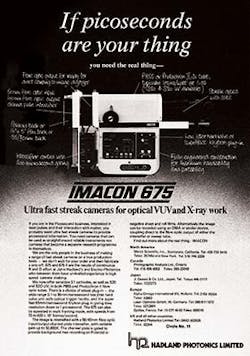More on framing and streak cameras' origins
I have received Laser Focus World for many, many years, and have advertised in and read the magazine since the mid '70s.
In the July 2015 issue, Jeff Hecht had an article that looks back and forward on the electro-optical revolution and transformation of cameras.
In that article, there was a copy of an ad on the IMACON 675 from the Hadland Photonics Ltd. company (see photo). Hadland Photonics was a UK company originally named John Hadland Photographic Instrumentation (JHPI), but after JHPI purchased Electro-Photonics Ltd. (an Irish company manufacturing streak cameras and owned by Dr. Dan Bradley), they later changed the name of the company to Hadland Photonics in about 1975. EPL had the design and was manufacturing a 1 ps streak camera, but it had trigger jitter far greater than the recording time window—which made it difficult to collect data reliably. JHPI was also building both framing and streak cameras at that time. I started work there in 1973, building and calibrating the IMACON systems. The IMACON 675 was the fastest framing and streak camera available, as it could produce up to 15 frames at up to 600 million frames/s (thus the number 6 in the name). The 75 in the name indicated it had a 75 mm fiber-optic faceplate to couple the phosphor image of the streak or frame data directly to Polaroid ASA 10,000 film for recording. CCD readouts were still many years away, as Hamamatsu and Thompson were not building picosecond streak cameras at the time. The 675 originally had about 3–5 ps time resolution, but it had a much better low-jitter sweep generator. So by combining the tube from EPL with 1 ps time resolution and the sweep generator from the 675, we had a streak camera with a max sweep speed of 10 ps/mm over 75 mm, producing a time window of 0.75 ns. With a slit width of 100 μm, it would give time resolution of 1ps and jitter less than 0.5 ns, so data could be recorded single-shot for every shot.
Many of the early high-energy laser development labs, such as LLNL, U. of Rochester, KMS, NRL, Sandia, LANL, Bell Labs, and many more, all used the IMACON 675 streak cameras.
From the early '70s to the mid '80s, Hadland Photonics was the source for picosecond streak cameras until Hamamatsu entered the streak technology market. After that, Hadland Photonics still produced pico- and nanosecond streak cameras with larger formats and better spatial resolution, and were still selling streak cameras up to the time when they were purchased and the UK offices were closed in 2002. Then, several of the engineers from Hadland Photonics started a new company, Specialised Imaging Ltd., to manufacture ultrafast ICCD framing cameras and the SIM line, which is now the go-to system for framing speeds up to 1 billion frames/s at megapixel resolution. It is used at all the national labs and government research facilities in the U.S. and around the world. We also manufacture the Kirana ultrahigh-speed video camera capable of frame rates up to 5 million frames/s for 180 frames, with 924 × 768 pixels per frame.
I have been selling and servicing the IMACON streak cameras since I moved back home from the UK in 1975. I represented and eventually ran the U.S.-based Hadland Photonics until we were purchased. Now, I am running the U.S. office for Specialised Imaging and also representing Optronis GmbH (Kehl, Germany), which now is the other commercial streak camera manufacturer besides Hamamatsu. Optronis offers a full line of streak cameras with down to <2 ps time resolution with large formats, and a nanosecond system with large 35 mm photocathodes and 40 mm phosphor screens. The Optronis cameras are now used at many labs, including ARL, LANL, Eglin AFB, and Sandia NL, and many universities, including U. Mich., U. Virginia, Mich. State, Case Western, UCLA, and McMaster and INO in Canada.
Ultrafast imaging, both streak and framing, offer a unique look into ultrafast events that cannot be achieved with single-point measurements. Streak manufacture is more difficult than framing because of the limited sources of streak tubes, which are large, expensive, time-consuming, and can only be manufactured in small batches. In recent years, we have seen a growth in the market based on new researchers rediscovering streak techniques in data collection. We have developed a combination framing/streak camera by allowing the researcher to couple the streak camera directly to the optical path of the framing cameras, giving both framing and streak data on the same event on the same optical path for direct comparison of 2D and streak image data.
There is a need for sales and applications engineers for both framing and streak cameras. I hope your magazine—and the articles in it—continue to stir the interest of the next generation of experimentalists to use framing and streak cameras in their research.
Frank Kosel is president of Specialised Imaging, Temecula, CA; e-mail: [email protected]; www.specialised-imaging.com.
